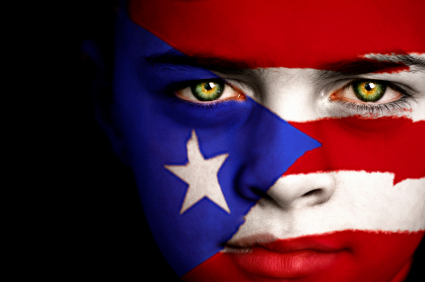
Undoubtedly, Puerto Rico’s history is a determining factor of the Spanish spoken there today. The influence of the indigenous language spoken in Borinquen (as Puerto Ricans call their nation) on the language brought by the Spanish is still evident. There are many inherited words, such as hamaca, macana, canoa, güiro and maraca. There are also many rivers and towns that have Taino names, such as Bayamón, Humacao, Guayama, Utuado and Vieques. Many of these words are exclusive to Puerto Rico and are not part of the international Spanish lexicon.
Some of the Puerto Rican words that are not in the Royal Academy Dictionary are: mofongo, envejeciente, candungo, guille, enfogonarse, pichear…
Another influencing factor on the language are the African languages that came to America with the slaves in the sixteenth century. Some of the “Africanisms” incorporated into Puerto Rican Spanish are: mondongo (tripe soup), gandúl (loafer), fufú (a spell), and malanga (a tuber).
Of course the biggest influence on the Puerto Rican language and culture comes from Spain. The original colonists that came to Puerto Rico in the fifteenth and eighteenth centuries, came from Andalucía. For this reason Puerto Rican Spanish has features that characteristic of Andalucian Spanish.
For example, the endings often omit the intervocalic “d” (ado-ido-edo). In both Seville and Puerto Rico people say “hablao” instead of “hablado”, “vendío” instead of “vendido”, and “deo” instead of “dedo”. Also from Seville comes the tendency to aspirate post-vocalic consonants, especially the letter “s”: for example, “lo do” instead of “los dos”. The south of Spain is also responsible for the trait of pronouncing “l” instead of “r”.
In the nineteenth century there was a new wave of colonists who arrived from the Canary Islands, which resulted in another strong contribution to Puerto Rican Spanish. As a result, the Canary Islands and Puerto Rico share a very similar intonation and syntax.
The Spanish-American war in 1898 resulted, for the Spanish, in the loss of their colonies in America and Asia, which were ceded to the United States. Although there was an attempt to impose English on the island (between 1902 and 1948 English was the main language taught in the country’s public schools), Spanish remains the mother tongue of Puerto Ricans. English has become the second official language in Puerto Rico.
Many Puerto Ricans have chosen to live in the United States and the influence of US language and culture in Puerto Rico is undeniable. Today, as many as four million Puerto Ricans live in the US. Recent reports indicate that in 2003, for the first time this number exceeded the number of people in Puerto Rico. The biggest concentration of Puerto Ricans in the United States is in New York.
Among other things, this migration has resulted in a phenomenon called “code-switching”, which is commonly known as “spanglish”. The mixture of languages is neither a separate dialect nor a unique characteristic of Puerto Rican culture. It is simply a convenient method of speaking used by people who are not entirely fluent in either of the languages.
A common “code-switch” in Puerto Rican Spanglish is the use of the word “so”: “Estoy tarde, so me voy”, instead of using the Spanish “porque” in a different configuration (“me voy porque estoy tarde”). Spanglish is also characterized by numerous words borrowed from English. But of course, in some cases, Spanglish becomes simply the misuse of English.
Pronunciation
Puerto Ricans, from various social classes, articulate “rr” with a “j” sound, such as “ajroj” for “arroz”. They also tend to neutralize the “r” and the “l” at the end of a syllable, as in “dolol” instead of “dolor” or “amol” rather than “amor”. The aspiration of the “s” at the end of a syllable, such as “ehcuela” instead of “escuela”, is also a common trait. The pronunciation of the letter “r” is also converted into “l’, for example, “corbata” becomes “colbata” or “cobbata” and “carne” becomes “calne” or “cahne”.
Sentence construction
Puerto Rico shares with much of the Hispanic Caribbean both pronominal redundancy and using the subject pronoun at the start of interrogative sentences. For example, the construction “¿cuántos años TÚ tienes?”, instead of “¿cuántos años tienes TÚ?”.
Puerto Rican identity
To be Puerto Rican is to have “la mancha del plátano” (the platano stain). In his poem “La mancha de plátano”, the Puerto Rican Luis Lloréns Torres describes the stain as one that “neither soap nor an iron could remove from me“ and that Puerto Ricans “carry the stain ‘por secula seculorum’”, that is to say, forever.
The platano stain
1. Set of spoken details or gestures that identify a Puerto Rican. (MAURA, 1984).
2. Refersto the specific character of Puerto Rico. (CLAUDIO DE LA TORRE, 1989).
3. Nature or character of the typicalPuerto Rican. (DRAE, 2001).





